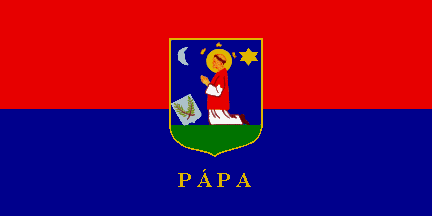
by Istvan Molnar, 13 August 2001

Last modified: 2001-08-23 by dov gutterman
Keywords: hungary | veszprem | papa |
Links: FOTW homepage |
search |
disclaimer and copyright |
write us |
mirrors

by Istvan Molnar, 13 August 2001
See also:
Pa'pa is a small beautiful town in Veszpre'm County in Hungary
near to Gyor (45 km) and Veszpre'm (55 km) at the borders of the
Bakony Mountains and the Little Hungarian Plains. The town has
got 34.419 inhabitants (1990 census) nearly all of them are
Hungarians. Three of the Official Ethnic Minorities of Hungary
has got ethnic council in the town. They are: Gipsy, German and
Polish.
The territory is populated from the Stone Age. There was founded
a cemetery of the Celts and Roman finds. In the 6th-7th centuries
in the territory of the town there was a bigger Avarian
settlement. In Borsosgyor (village united the town in 1973) there
was an Avarian entrenchment (gyor ~ gyuru in English means ring).
After the Avars, the Slovenes had arrived they gave the name of
the brook of Pa'pa: Tapolca (in English means: hot water
brook).
The first mention of the town was in 1061. It was a borough in
1389 under the rule of the Garai family. In 1401 there was a
meeting of the Lords of Hungary convened by King Sigismund. The
Fort Pa'pa was built in 1444. In 1482 Pa'pa was a Royal Town with
3.000 inhabitants. In the time of the Turkish War (1525-1699)
Pa'pa was an important border fortress. It was sieged by the
Ottomans in 1543, 1551 and 1594. 1594-1597 and in 1683 was under
Turkish rule. In 1531 was found the Calvinist School, 1585-1952
it was a High School of the Calvinists. In January 1704 the town
led by the capitan of the fort Pa'pa, La'szlo' Sa'ndor joined to
Prince Ra'ko'czi. At the time of the Prince Ra'ko'czi's
Independent War the fort often changed hands. In 1707, when the
Habsburg Army occupied the fort, it burnt up the town. In 1752
the fort was destroyed. Ka'roly Esterha'zy, the landlord of Pa'pa
built the castle in 1783-1784. At the time of the Revolution and
Independent War (1848-1849) citizens of Pa'pa take up arms and
went to the battles eagerly. After the defeat the war leaders of
Pa'pa were took prisoner. At the end of the 19th century Pa'pa
was growing quickly. Because Pa'pa had got an airfield (from
1937), it was bombarded
in the WWII. Three villages was united with Pa'pa: Borsosgy?r
(1973), Ke'ttornyu'lak (1977) and Tapolcafo~ (1982).
The coat of arms shows Saint Stephen, the martyr, whom name is
the title of the parish church. The first picture of the CoA is
from 1687.
You can see: former Esterha'zy Mansion (baroque 1783-1784) built
on the place of the destroyed fort, St Stephen Parish
"Old" Church (1774-1786), Museum of the Local History,
former Stable now Hotel Plata'n (classicist), High Square
(baroque), House "on Legs" or Arcade,
"Gate-House" (1750), Zichy House, Korvin Street,
Franciscan Church (1678-1764), Hotel Griff (1790),
Baroque-Classicist Reformed "Old" Church (1783-1784),
former City Hall (1823), Benedict Church (1737-1742) and former
Benedict High School, City Hall (1757-1898), former County Ha